Qiu Cheng ( - 1380 )
Alas, Little Information
General Qiu Cheng, a native of Hanshang, Anhui Province, was one of Zhu Yuanzhang's trusted aids.

Entrance with platform in front
However, trawling through numerous books and other litterature in the English language I have yet to come across any mention of this general.
He clearly played an important role in most of the Hongwu reign (1368-1398). This is evidenced by the sheer fact that the Emperor allowed him a mausoleum on the same mountain that he himself later would be interred on.
The Emperor's trust in him can be deduced from the fact that Qiu Cheng survived the many and wide-ranging purges, which took place during the Hongwu regime.
I shall greatly appreciate any reference to material on this person in the English language.
Location

Path leading up to the tomb wall
Qiu's mausoleum is located close to Taiping gate on the northern side of the foot of Zijin mountain, a subsection of Nanjing's Zhongshan mountain. It sits almost hidden from view inside a grove of broadleaved trees, which again is part of the large, forested area covering most of Zhongshan mountain.
Most of the trees around this mausoleum are relatively newly planted and thus far younger than those of the surrounding forrested mountain area.
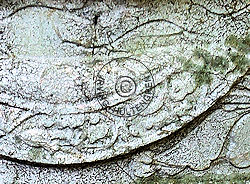
Masonry detail
This mausoleum lies only some 100-200 meters from that of Chang Yuchun. But whereas the mausoleum of the latter has been rebuilt, restored and kept tidy, Qiu Cheng's mausoleum does not bear any trace of special care and attention by descendants. Presumably only the relevant authorities are keeping the mausoleum tidy.
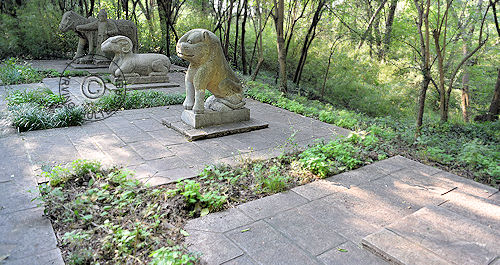
Southern group of statues
Note the missing soldier on right
Upon Qiu Cheng's death, the Emperor bestowed him the honorary title of "Duke of Wanguo", and - not to forget - allowed him to be interred on Zhongshan mountain (see above).
As is the case of Chang Yuchun, Qiu Cheng is most likely not buried in this precise location but rather somewhere else on Zhongshan mountain.
Mausoleum Layout
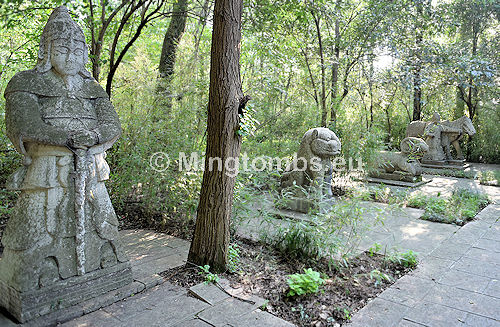
Northern group of statues
The mausoleum comprises of three sections: A small platform followed by an access path, an area with statues placed symmetrically on both sides of the center path and a tomb wall on an elevated platform. There is no discernable tomb mound.
This is one of the simplest of all the Ming mausolea on Zhongshan mountain.
Access Path
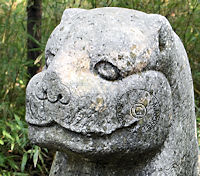
Tiger face
The access path commences with a small, square platform at the mausoleum entrance. The path runs straight north for some 30 meters and then abruptly turns perpendicularly east. After the turn the path runs straight another 30 meters until it terminates at the tomb platform. The path is some two meters wide and overall in good condition.
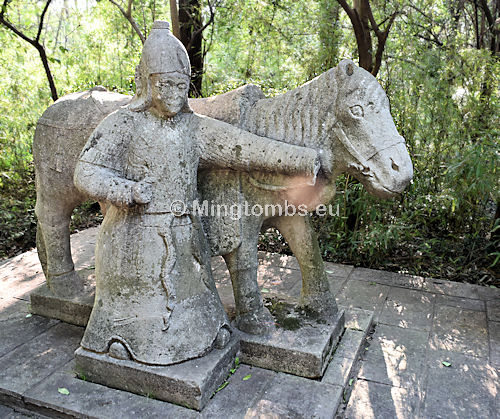
Northern horse and attendant
Stone Statues
Originally, four statues lined each side of the access path, but one of the statues - the northern soldier - has since gone missing. From west to east each side had a horse with attendant, a ram, a tiger and a soldier.
Horse and Attendant
A horse held by a horse attendant adorns the westernmost ("first") platforms. On both sides the attendant stands on the side of the horse that faces the tomb wall as if awaiting the deceased to return and mount the horse for a ride.

Knotted robe
The horse attendant wears a headgear and a sparsely decorated robe held in place by a knotted rope. He holds the horse by the reins with his left hand and rests his right arm horizontally across his chest, a common posture for such stone masonry at the time. He gives an impression of readiness, submissiveness and patience.
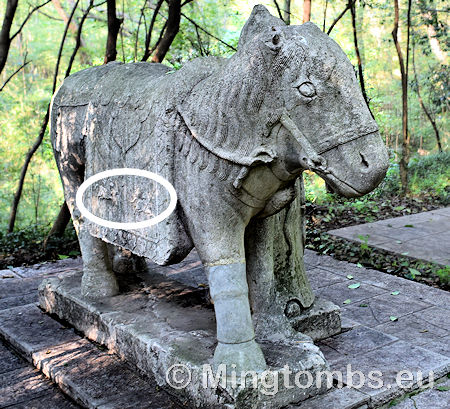
Southern horse -playful animals circled
The horses are nicely groomed and fully equipped with reins and saddle, ready for a ride. Masonry details are of high quality, including eyes, nostrils and individual strands on the mane.
The saddles are extended down the sides. The visible part on the other side of the attendant are nicely decorated with patterns and two small, four-legged and running animals at the lower end.
Both statues have lost the part of the rein that would have extended from the body proper and to the bit of the bridle on the opposite side of the attendant. Likewise, the same section of the reins as well as the attendant's hand are missing on the attendant side of the horse.
Minor repairs can be seen on both statues, such as for instance a subsection of one horse leg.
Apart from the above and the missing tails then the statues are both generally in good condition.
Compared to the statue of the soldier then the horse and attendant statues are rather small in size.

Ram (northern)
Ram
Next towards the tomb wall are the platforms with a ram. The rams are lying down on the platform, facing the center path.
The rams have beuatifully curved horns and their fur is distinctly chisseled. Thir tails are tucked in.
Sheep -frequently pictured as rams- are generally a sign of luck as well as filial gratitude, but used at a mausoleum as in this case then the animal stands for justice. In broader terms the presence of the sheep in the mausoleum ensures that only righteous people can pass.
When used in imperial mausolea then the sheep are normally replaced with the mystical beast of a horned Xiezie, which could identify and gore people, who had committed crimes.

Tiger
Tiger
Closer yet to the tomb mound are the platforms with tigers. They have been cut into the traditional posture and shape prevalent in the early Ming Dynasty.
They are in a sitting pose, resting on the hind legs with the tail neatly curled up under the body.
Tigers are fierce and powerful and in China normally used metaphorically for great people. Asians consider the tiger as the "King of all Beasts" and not the lion.
Also in Asia the tiger is considered the protector of the dead and therefore often placed in mausolea in order to assure peace for the tomb occupant, who has passed away.
As is customary, the fur decoration is a mix of curvy lines and scales. The tiger has a solid, muscular body and the leg muscles appear strong and able.
Particularly the northern tiger statue has had the need for substantial restoration in both front legs and the entire lower body part.

Soldier
Soldier
The last platforms lining the center pathway were meant to house the guarding soldiers. But only the southernmost soldier remains at the mausoleum, the other platform is empty.
He stands erect, resting with both hands folded on his sword handle. He wears a cape, a (leather) helmet and heavy protective armor over most of his body.

Back
The lower part of the breast plate and the belt carry some decoration. Part of his clothing is held in place with a knotted rope, the ends of which almost reach all the way to the ground.
Whereas the front carries few decorations, the back side is richly adorned. The cape at the top is quite simple with only the folds cut into the stone. The back and bottom plates of the protective armor are however beautifully carved with various patterns like bands, swirling clouds, huge waves etc. It would only require minor cleaning to display clearly the great masonry skills used.
Nature runs its course evidenced by the fact that the front side facing north is quite overgrown with moss over knee-height and the back side facing south is mostly free from moss (as it is drier).
The soldier, who has a goatee, appears alert and fully prepared to defend the mausoleum occupant should the need arise.
Platform and Wall

Platform and wall
The center path terminates at an elevated platform on which stands the tomb wall.
The wall is 8 meters wide and 1 meter tall. It carries no decoration and no inscription.
As there is no discernable mound behind the wall it is mostly symbolic and merely serves as a memorial.
As stated earlier, it is highly unlikely that Qiu Cheng is interred in this particular location.